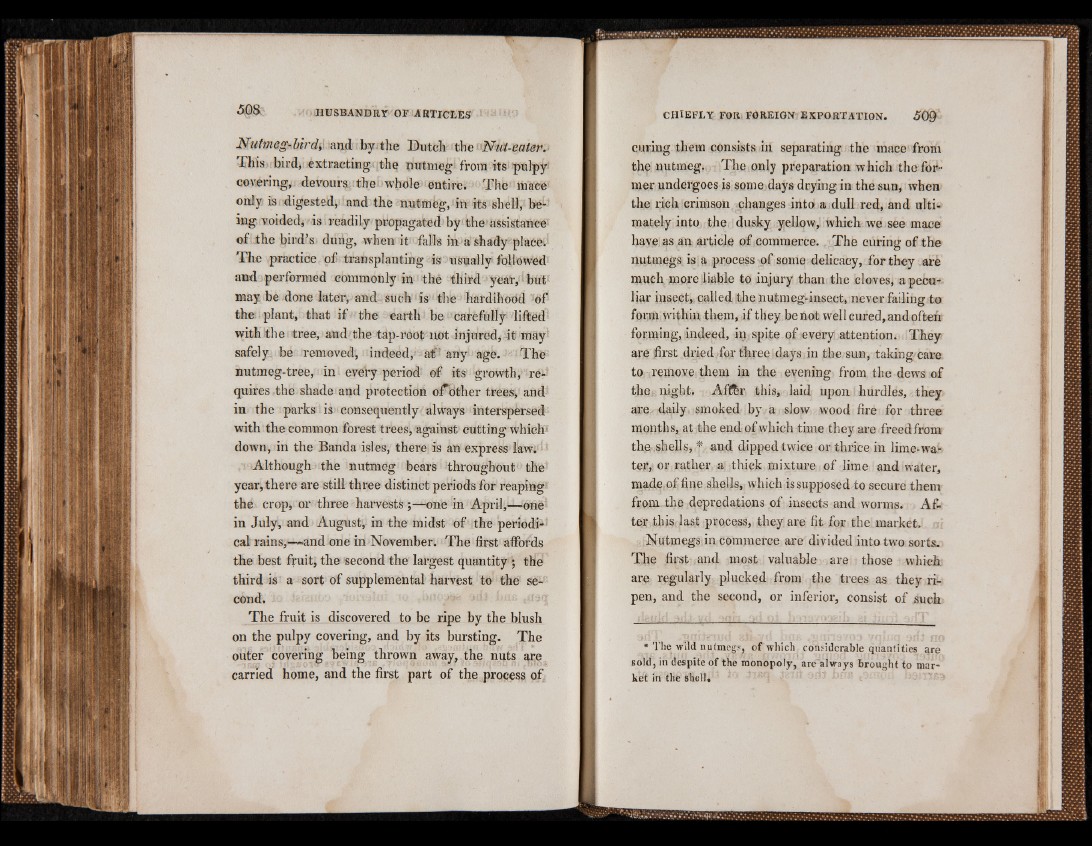
Nutmeg-birdy and. by the Dutch the Nut-ealer.-
-This bird, extracting the nutmeg from its pulpy1
covering, devours, the* whole entire. The mace
only is digested, and the nutmeg, in its shell, being
voided* is readily propagated by the assistance
of the bird’s dung, when it falls in a shady place.
The practice of transplanting is usually followed
and performed commonly in the third year, but
may be done later, and such is the hardihood of
the plant, that if the earth be carefully lifted
with the tree, and the tap-root not injured, it may-
safely be removed, indeed,' at' any age. The
nutmeg-tree, in every period of its growth, requires
the shade and protection o f Other trees, and
in the parks is consequently always interspersed
with the common forest trees, against cutting which*
down, in the Banda isles, there is an express law; '
Although the nutmeg bears throughout the
year, there are still three distinct periods for reaping1
the crop, or three harvests ;—one in April,—one
in July, and August, in the midst of the periodical
rains,—-and one in November. The first affords
the best fruit, the second the largest quantity ; the
third is a sort of supplemental harvest to the second.
The fruit is discovered to be ripe by the blush
on the pulpy covering, and by its bursting. The
outer covering being thrown away, the nuts are
carried home, and the first part of the process of
curing them consists in separating the mace from
the nutmeg. The only preparation which the former
undergoes is some days drying in the sun, when
the rich crimson changes into a dull red, and ultimately
into the dusky yellow, which we see mace
have as an article of commerce. The curing of the
nutmegs is a process of some delicacy, for they are
much more liable to injury than the cloves, a peculiar
insect,, called the nutmeg-inseet, never failing to
form within them, if they be not well cured, and often
forming, indeed, in spite of every attention. They
are first dried for three days in the sun, taking care
to remove them in the evening from the dews of
the night. Afffcr this, laid upon hurdles, they
are daily smoked by a slow wood fire for three
months, at the end of which time they are freed from
the shells, * and dipped twice or thrice in lime-water,
or rather a thick mixture of lime and water,
made of fine shells, which issupposed to secure them
from the depredations of insects and worms. After
this last process, they are fit for the market.
Nutmegs in commerce are divided into two sorts.
The first and most valuable are those which
are regularly plucked from the trees as they ripen,
and the second, or inferior, consist of such
* The wild nutmegs, of which considerable quantities qre
sold, in despite of the monopoly, are always brought to market
in the shell.